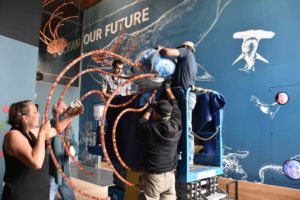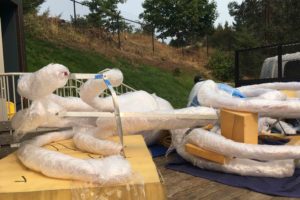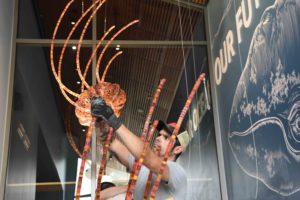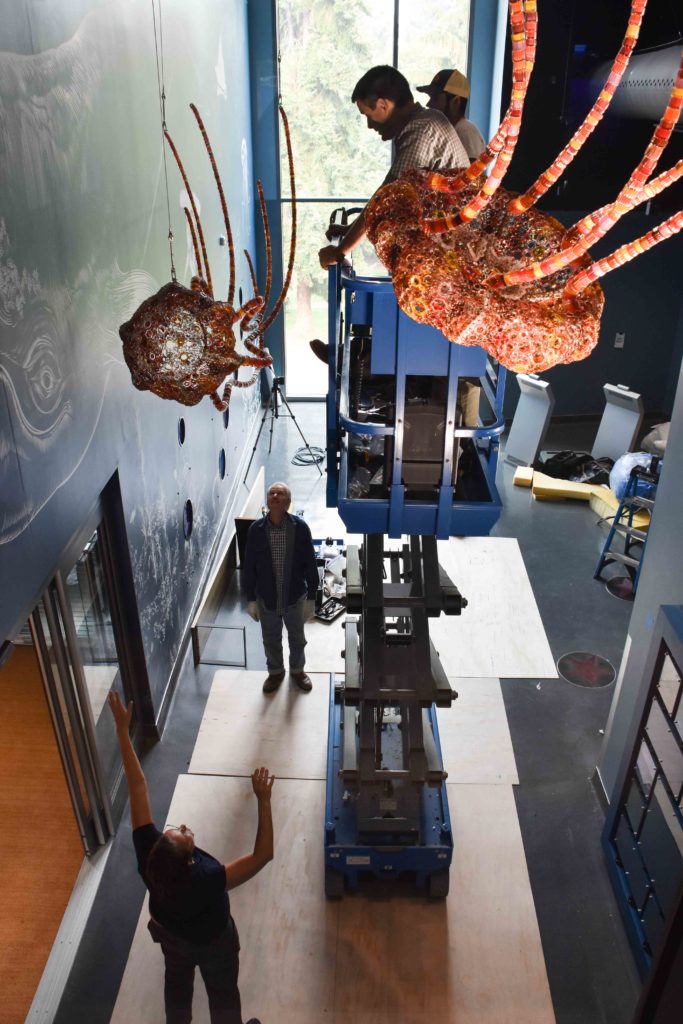“Do you need more padding?”
Kait Rhoads is standing, hands on hips, near a tentacled lump swathed in bubble wrap. Four men hover, poised to act. As one micro-adjusts a padding blanket on a lift, the others set hands on the bubble wrap.
“Ready? One, two, three, up!”

With two weeks to go until the Pacific Seas Aquarium opens, artist Kait Rhoads is installing her “Salish Nettles” – three giant jellyfish made of hundreds of tiny glass hexagons.
Blown, assembled and engineered by a community of helpers, the jellyfish sparkle and glimmer in a wire-woven mosaic of orange, red and gold. Individually, they symbolize the beauty of the ocean, pulsing mid-air overhead in the aquarium’s Waves of Change gallery. Collectively, they sing in chorus with the teal walls and massive whale mural of the fragility of that ocean – and how humans must protect it. They’re a part of the aquarium’s public art, funded by the 1% of all Metro Parks Tacoma public works projects set aside for art.
But they also weigh around 80 pounds each, and hanging them takes hours of careful choreography.

“I wrapped the heck out of them and loaded them on a flatbed truck to bring them down here,” explains Rhoads, who has spent the last six months weaving glass onto steel bells and threading it onto tentacles with copper wire in her Seattle studio.
Rhoads had already hired an engineer to determine the best hanging points for the jellyfish’s steel support rings. Working to the engineering designs, the crew of Seattle-based Fabrication Specialists had spent the previous day prying open ceiling panels and securing long steel cables – three or four per jellyfish, depending on its weight.

Now the moment had come to tie them on. After hoisting the sculpture carefully onto the lift (the bell still bubble-wrapped), two crew members raised the machine ten feet up and starting attaching cables to rings, crimping each one through a round pulley. From the ground, Rhoads watched, eagle-eyed. She’d already repaired a couple of small breaks in the tiny blown-glass hexagons that made up the jellyfish, and each repair took hours.
“It’s gone pretty well,” said Gerald McGinness, Fabrication Specialists principal and himself a sculptor with years of public art installation under his belt. “The only uncertainty was the ceiling panels, and that worked out just fine.”
Finally, the moment came. With all four cables taking the 83-pound weight of the third jellyfish, the crewmembers lowered the lift with infinite care out from under the sculpture and cut off the last of the bubble-wrap to reveal a spotlit mosaic of glass, floating high in a sea of blue.
“I’m so happy,” said Rhoads, a broad smile on her face. “I’ve been working on this sculpture since I applied 15 months ago for the public art program. It really pops in this space. And the size – When I was a kid I visited the American Museum of Natural History in New York with that huge whale, so inspiring. There’s just something about bringing the height and size of nature into our human world. People need to be confronted by it.”

Upstairs in the aquarium entrance, Zoo aquarist and jellyfish expert Dr. Chad Widmer gazed down at the three enormous sculptures inspired by the animals he cares for every day.
“They’re beautiful, I love so many things about them,” says Widmer, himself a glassblower. “Kait got the community involved to make them, so we’re all a part of them. And her artistry gives them life.”
Back downstairs, Rhoads is directing the crew as they adjust cable turnbuckles to play with the angle of the sculptures.
“I’m so glad I could do this,” she says. “I hope this art inspires people of all ages to conservation, and protecting the ocean.”
-Rosemary Ponnekanti, PDZA
“Salish Nettles” By-the-Numbers
Jellyfish: 3
Weights: 87, 83 and 75 pounds
Total tentacles: 17
Glass pieces: Thousands. “I don’t count them!” says Rhoads.
Hours to create: 632 from Rhoads (development, drawing, sorting glass and weaving) plus over 100 from volunteers (blowing and weaving glass)